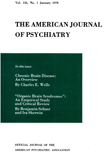TOXIC PSYCHOSIS WITH TRANSIENT DYSMNESTIC SYNDROME FOLLOWING WITHDRAWAL FROM VALIUM
Abstract
The psychosis which follows barbiturate withdrawal(2) is also often heralded by a grand-mal seizure. The delirium begins on about the third day, and includes agitation and hallucinations. Mayer-Gross(2) states that a dysmnestic syndrome following a delirium is not rare, usually occurs when consciousness is clear but that the delirium can recur at night. "Eventual recovery is almost invariable."
Of interest is the fact that the patient reported hallucinations in four different sensory modalities.
Access content
To read the fulltext, please use one of the options below to sign in or purchase access.- Personal login
- Institutional Login
- Sign in via OpenAthens
- Register for access
-
Please login/register if you wish to pair your device and check access availability.
Not a subscriber?
PsychiatryOnline subscription options offer access to the DSM-5 library, books, journals, CME, and patient resources. This all-in-one virtual library provides psychiatrists and mental health professionals with key resources for diagnosis, treatment, research, and professional development.
Need more help? PsychiatryOnline Customer Service may be reached by emailing [email protected] or by calling 800-368-5777 (in the U.S.) or 703-907-7322 (outside the U.S.).



